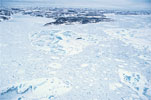 Teacher
Guide For Antarctica
Teacher
Guide For Antarctica
When you think of Antarctica, you probably picture ice and snow. Except for some areas, this may actually be fairly accurate. It is the fifth largest continent in terms of area, and it covers over five million square miles or over fourteen million square kilometers. This continent is centered close to the South Pole, but not placed exactly around it, and it is almost all inside the Antarctic Circle.
There are two major regions in Antarctica, West and East Antarctica. These two areas are joined together into one land mass by a sheet of ice that is thousands of feet in thickness.
More than 95% of Antarctica is covered at least somewhat by ice. There are some islands and dry valleys that aren't ice-covered. Some of the mountain ranges of the continent are even buried below the ice! The surface rises to a high point of about 13,000 feet or 4,000 meters. There are over one hundred lakes that are not frozen, beneath the ice. Some of the lakes are connected to each other by rivers that run beneath the glaciers.
Not surprisingly, the weather in Antarctica is filled with high winds, low temperatures and frequently severe blizzards. In the coastal areas, the weather changes rapidly, but even in the warmest months, they are usually at freezing temperature or below. In winter, the lowest temperatures can be -40F. There is almost continuous and total darkness in the winter, which causes Antarctica to be the coldest place anywhere on Earth. Their lowest recorded temperature was -127F or -88.3C at a Russian station on the continent.
No humans are native to Antarctica, and there aren't any large animals that live on the land there. There is microscopic life in the melted ponds, tiny insects, lichens and moss, and some plants. Seals and birds that live on the land part of the time depend on the sea for their food. The waters in Antarctica have much plankton, a feeding staple for Adelie penguins, crab eater seals and baleen whales.
Elephant and fur seals that spend their summers on the northern islands of the Antarctic area were hunted in the 19th century, and then in the 20th century, man began hunting the whales. The seals' numbers are on the rise now, and commercial whaling is prohibited, although not all countries obey the moratorium.
Antarctica was thought to exist long before it was actually discovered. All of the expeditions headed there were thwarted by ice. John Davis, an American, landed first on Antarctica in 1821, and eleven men from a ship-wrecked vessel spent the winter there, although not by choice.
After the 1820's, the hunting of fur seals was on the decline, and in the first part of the 19th century, a Russian expedition circumnavigated Antarctica. After World War I, there was more exploration of the area, and the first airplane flew over Antarctica in 1928. An American explorer named Richard Byrd coordinated aerial cameras, airplanes, tractors and radios to explore the icy area.
In the 1930's, there was a great deal of rivalry among nations to see who could claim the land of Antarctica. There were some claims that overlapped each other. The United States did not claim any land, but they did support the exploration of the area. They were the first to set up a permanent base, for the purpose of further exploration.